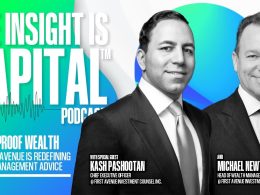Let’s face it—when markets are calm, it's easy to get comfortable. But that comfort can be a trap. In their recent whitepaper1, Meketa’s Zachary Driscoll and Lauren Giordano issue a reminder that’s hard to ignore: the real risk isn’t volatility itself—it’s being unprepared when it hits. And for those looking to strengthen their portfolios against the unexpected, long volatility strategies deserve a serious look.
These aren’t just tools for market doomsayers. As Driscoll and Giordano explain, “Long volatility strategies are investment approaches that aim to profit from rising levels of actual or expected volatility in financial markets… typically involving assets that benefit from increased market volatility, such as options or other derivative instruments.” In other words, when markets panic, long volatility is designed to shine.
But Meketa goes further. They frame long volatility as a “first responder” in their Risk Mitigating Strategies (RMS) toolkit—on par with long-term Treasuries and tail-risk hedges. It’s not just a reactive defense mechanism. It’s proactive protection.
Not a Bet, a Buffer
What makes long volatility strategies stand out? Simple. They tend to work when other investments don’t.
Driscoll and Giordano lay it out: “The appeal is their ability to serve as a defense mechanism against sharp, quick drawdowns in global markets.” Take the 2022 meltdown, for instance. Stocks dropped. Bonds dropped. Long volatility? Up. That’s the whole point. These strategies aren’t about boosting returns in good times—they’re about saving your skin when things get ugly.
Since 2005, the Eurekahedge Long Volatility Index has delivered 3.3% annually—roughly in line with investment-grade bonds. But that’s just the surface. The real value is how these strategies behave in crises.
How the Strategy Actually Works
Volatility, boiled down, just means uncertainty. And long volatility strategies profit when that uncertainty spikes.
The mechanics can vary. Some managers trade VIX futures. Others use options, straddles, or more complex derivatives across stocks, bonds, commodities, and currencies. The basic idea? Own instruments that jump in value when the market freaks out.
One common tactic is exploiting the gap between “implied volatility” (what the market thinks might happen) and “realized volatility” (what actually happens). When the market gets that wrong, savvy managers can profit.
Another lever is the “volatility term structure”—how expectations change depending on the timeline. Just like bond investors look at yield curves, long vol managers study how volatility is priced over time to spot opportunities.
The Power of Convexity and Correlation
Here’s where long volatility really earns its keep: diversification. It behaves differently. Since 2005, it’s had a strong negative correlation to global equities (-0.46) and high-yield bonds (-0.38). That’s exactly what you want when everything else is crashing.
Even better, long volatility offers positive convexity—meaning it gains more in a downturn than it loses in an upswing. As Meketa puts it, “In extremely negative historical months for equities, long volatility has been, on average, a highly positive returning strategy.”
And when compared to traditional safe havens like gold or long-dated Treasuries? Long volatility often does better at delivering consistent crisis protection.
Of course, this comes at a price. In quiet markets, long volatility can be a drag. That’s where patience—and understanding the role of the strategy—really matters.
Fees, Liquidity, and What to Watch For
Driscoll and Giordano are candid about the nuances. First off: fees. Many long vol strategies are hedge funds, which means performance fees. And during times when the rest of your portfolio is hurting, paying hefty fees on your one winning position can sting.
“Investors may prefer flat fee arrangements,” they note, especially since the fund’s role is more about cushioning losses than chasing alpha.
Liquidity matters too. If the strategy works but you can’t access the cash when markets tank, the whole point is lost. Most strategies offer monthly liquidity—but those dabbling in exotic markets may be harder to exit quickly. Know what you’re getting into.
One Size Doesn’t Fit All
Not every long volatility manager plays the same game. Some focus just on equity volatility. Others diversify across asset classes. Some use short-term options, others go long-dated. Meketa warns: “It is unlikely that any two long volatility investment managers will have an identical approach.”
Benchmarking is tricky too. There's no perfect index. The Eurekahedge index is useful, but it’s not investable—and it may not reflect your manager’s strategy mix. The VIX? It's just a sentiment gauge. Meketa encourages investors to focus less on beating a benchmark and more on whether the strategy is actually doing its job: protecting when it matters most.
The Role Within Meketa’s RMS Framework
Within Meketa’s RMS framework, long volatility sits squarely in the “First Responder” category—meant to act fast when equity markets turn south. It’s one of three tools they recommend:
- Correlation Hedge: Long Treasuries
- Structural Hedge: Long Volatility
- Explicit Hedge: Tail Risk
Each has its own trade-offs—cost, reliability, expected payoff. Long volatility sits somewhere in the middle: more reliable than Treasuries, cheaper than tail-risk insurance, and with a better chance of paying off meaningfully during a drawdown.
Are You Ready to Hold Through the Quiet?
This is the make-or-break question. Can you stomach holding long volatility through years of low volatility—when it might underperform—just to be ready for that one big shock?
As the authors ask, “Can I afford to hold this until an event happens?” Because here’s the truth: markets can stay calm for a long time. But they never stay calm forever.
And when the storm hits, long volatility is one of the few strategies built to respond in real time.
Key Takeaways for Advisors and Allocators
- Think function, not flash: Long volatility isn’t a growth engine—it’s a seatbelt.
- Size it right: Too small, and it won’t help. Too large, and the carry drag becomes painful.
- Diversify by design: Equity-only volatility may not cut it in a multi-asset portfolio.
- Match your expectations: If you expect returns like equities, this isn’t the strategy for you.
- Stay the course: If you bail during the calm, you’ll miss the payoff during the storm.
As Meketa puts it: “Long volatility strategies will remain a valuable tool for navigating periods of heightened volatility and trying to ensure long-term portfolio stability.”
1 "Long volatility investment strategies primer - Meketa Investment Group." Meketa Investment Group, 28 Feb. 2025
Copyright © AdvisorAnalyst














